The bikes’ 1000cc engines produce 270hp but their tiny contact patches and lack of downforce relative to cars costs them dearly in lap time when compared to a Formula 1 machine.
For example, Valtteri Bottas lapped his 2019 F1 Mercedes in 1m32.029s in qualifying for the US Grand Prix at Austin’s Circuit of the Americas, compared with Maverick Vinales’ 2m00.864s in MotoGP qualifying there in 2024.
However, a few years ago Red Bull pitted Dani Pedrosa’s KTM RC16 against Liam Lawson in an RB8 over a quarter of a mile from a standing start, and the bike won hands-down – mainly thanks to its superior power-to-weight ratio (the RB8 weighing in at 640kg compared to the KTM’s 157kg).
Their narrow nature also means very little drag, allowing MotoGP bikes to max out at around that 220mph mark. Which is all well and good in a straight line, but how do you get them slowed down for the twisty bits?
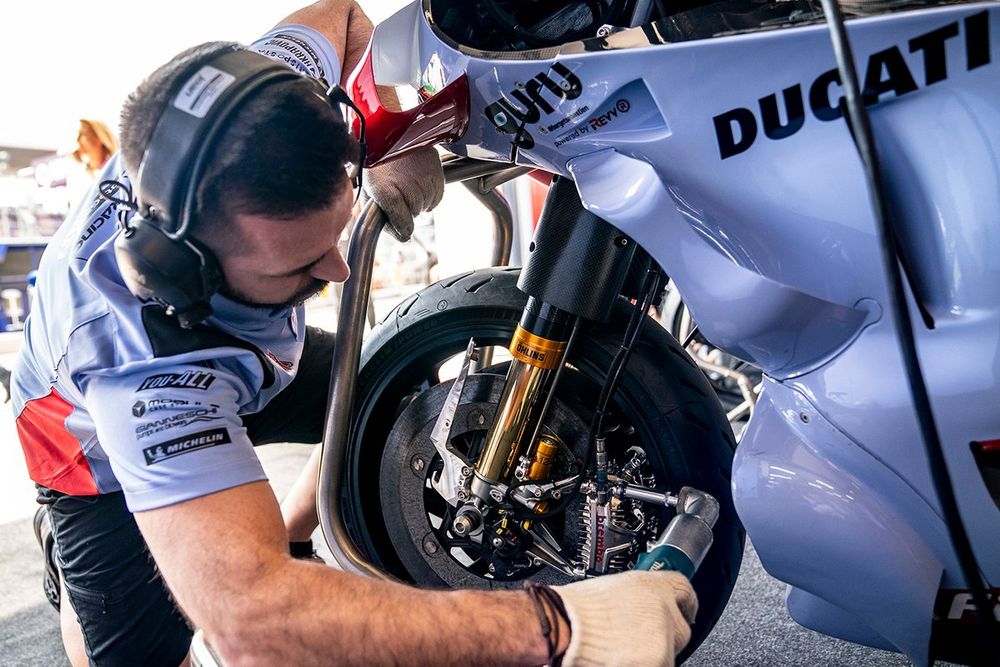
MotoGP disc brake detail
Photo by: Brembo
What’s the technology behind MotoGP brakes & who makes them?
For the ninth season running, Italian-based Brembo supplies all 22 MotoGP riders with a fully-customized braking system and service. The components of the system are brake calipers, carbon and steel discs, master cylinders, clutch pumps and pads.
Its monobloc caliper, called the GP4, is machined from a solid piece of aluminum. It features an amplification system that allows the braking torque to be increased, which means that the rider gets greater benefit from applying the same pressure to the brake lever.
Meanwhile, a spring device on the anti-drag system reduces the residual torque and stops the pads and discs coming into contact with each other.
Immense stopping power is generated by the use of carbon front discs: Brembo offers different diameter sizes and each is available in three material specs – finned, high mass and standard. A smaller diameter steel disc is used at the rear, as engine braking assists with the process on that end.
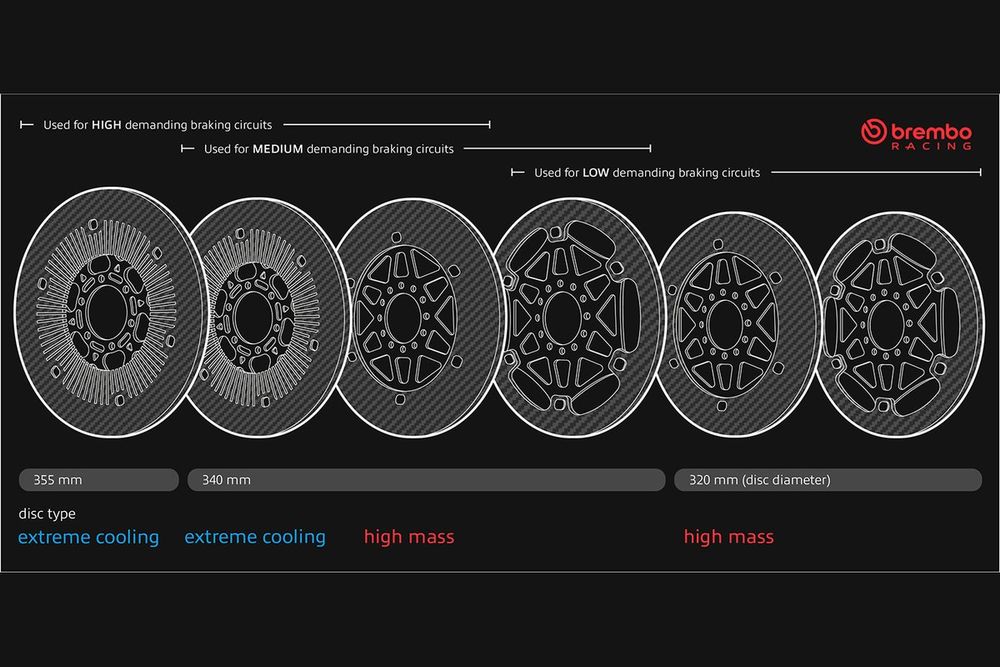
MotoGP disc brake options
Photo by: Brembo
During the season, most riders use 340mm diameter carbon discs, splitting between high mass (for higher-end requirements) and standard mass (low end) – with 320mm also available. Ventilated disc solutions, one option with a diameter of 355mm, are available for more demanding circuits such as Spielberg, Buddh, Motegi, Buriram and Sepang.
The thickness of the discs, regardless of diameter, is 8mm, while their weight varies between 1kg and 1.4kg depending on the diameter and specification used.
So that means MotoGP brakes are actually larger, in terms of diameter, than an F1 car’s but far thinner (F1 brakes are 32mm wide). Overall, between front and rear wheels, the MotoGP braking system weighs about 5.5kg in total.
The operating temperature of a MotoGP carbon disc must be between 250°C and 850°C. In comparison, the steel discs that Brembo makes for Moto2 and Moto3 operate between 100°C and 650°C.
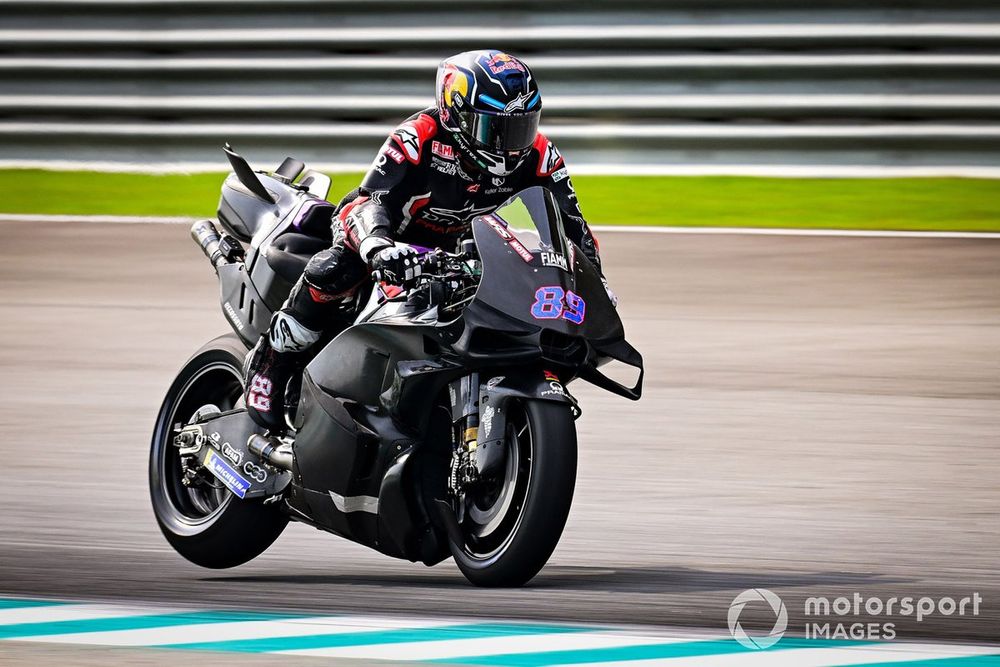
Jorge Martin, Pramac Racing
Photo by: Gold and Goose / Motorsport Images
How quickly can a MotoGP bike slow down?
MotoGP bikes weigh 157kg and, along with their jockey-sized riders, they can decelerate at just over 1.5g. Let’s look at a real-world scenario, at last weekend’s Grand Prix of the Americas at COTA.
The biggest stop at that circuit – which is classified as ‘medium’ in terms of braking effort, at 26% of the total lap spent slowing down – is at the end of the back straight. The approach speed on the back straight to Turn 12 is 338km/h – close to their maximum velocity of 220mph in imperial measures – and the minimum corner speed is 65km/h.
It requires a 293-meter stopping distance, which takes 5.8s. The brake pressure required is 12.5 bar (NOTE: One bar is roughly the atmospheric pressure on Earth at an altitude of 111 metres at 15°C), and the maximum braking power is 120kW x 2.
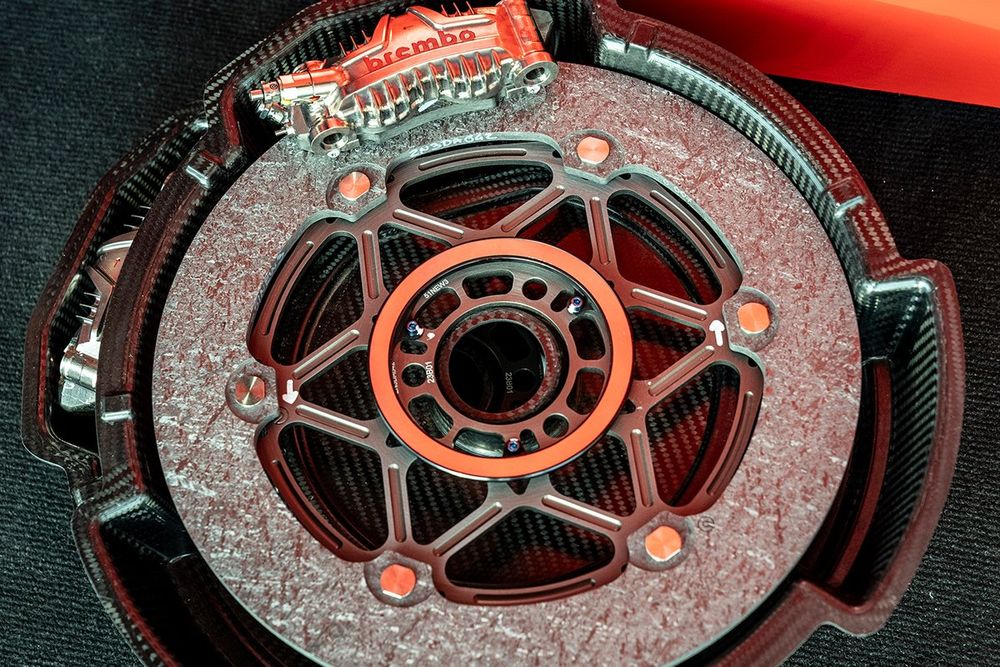
MotoGP carbon disc brake detail
Photo by: Brembo
“The part where the carbon disc is most effective is when the heat dissipation takes place,” says Brembo’s MotoGP race engineer Mattia Tombolan. “Due to the properties of the carbon material itself, it can absorb a lot more heat than a steel disc, but it can also dissipate it very quickly.
“To have that same level of dissipation with steel, you’d need a very big disc which would be a lot heavier. And the weight has a huge impact on the maneuverability of the bike.”
The size of a carbon disc also has a knock-on effect through the rest of the system.
“Looking at the dimension of the disc, this has a direct impact on the braking torque applied by the rider,” he adds. “A larger disc also generates a greater gyroscopic effect that hampers a bike and rider’s ability to change direction.
“If I’m putting the same pressure on the master cylinder, if I have a bigger disc, with a higher radius with higher momentum, I will put higher braking torque. So, the rider will feel he has to put less pressure to reach the braking force he wants.
“On the other hand, a smaller disc means a rider has to put much more pressure – so it depends on the rider preference.”
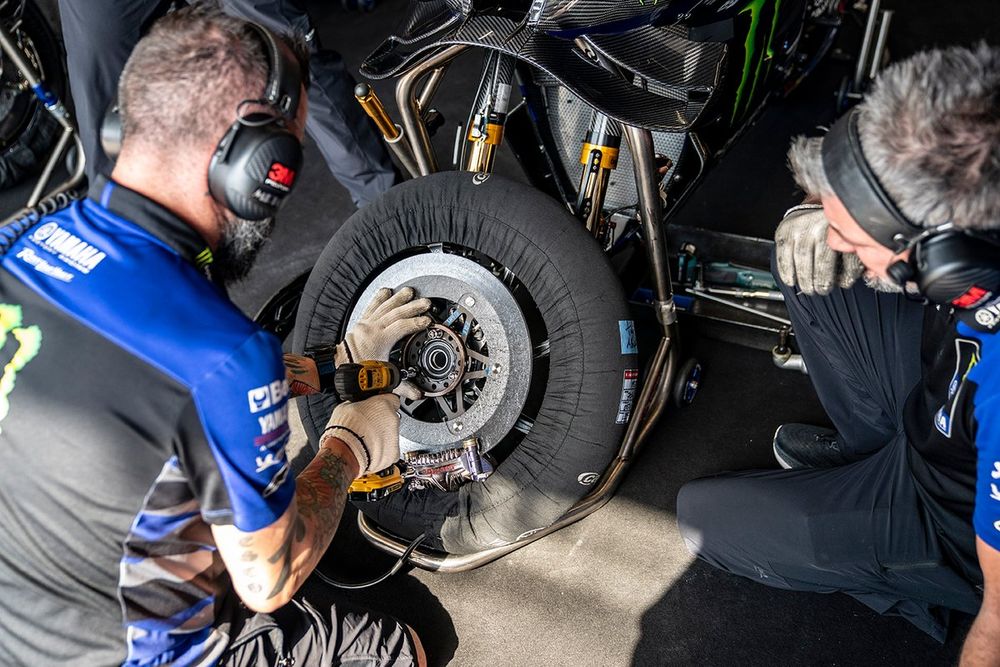
MotoGP disc brake detail
Photo by: Brembo
Although the science is the same as the braking systems in F1, the way the pilot initiates the interface – in F1’s case, stamping on the left pedal with huge force – is totally different.
“When you put over 100 bar with your foot, you’re also using the deceleration of the machine to help you,” says Tombolan. “In MotoGP, you are talking between 10 and 15 bar, applying that with your fingers.
“I would say the feeling of a MotoGP rider is more important, and don’t forget the rider is also moving around on the bike, they are not strapped in. So, I’d say the rider feedback is even more important when it comes to the engineering part, to translate the feeling of the rider and not just the numbers.
“It’s quite tricky, in MotoGP you really need to build a relationship with the rider and crew chief to tune the bike from the braking side.”
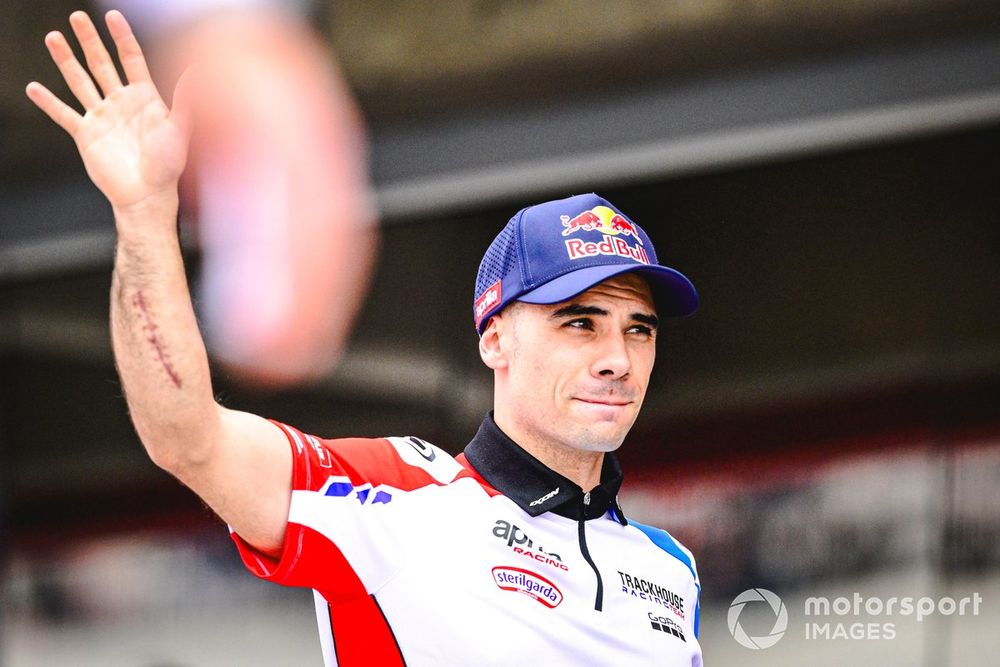
Miguel Oliveira, Trackhouse Racing Team
Photo by: Gold and Goose / Motorsport Images
The MotoGP rider’s guide to braking
Trackhouse Racing’s Miguel Oliveira has been racing in MotoGP since 2019 and has five wins to his name in the premier class.
The 29-year-old Portuguese rider, who has won races with both the factory and Tech3 KTM teams, now rides an Aprilia for the American-owned squad.
He explains what it’s like to ride one of these 220mph machines, and to discover where the limit is to slow them down from their top speed into a 35mph hairpin bend.
“The first question in terms of the braking is: What is 100%?” he asks rhetorically. “You have to find the limit. And usually our limit on the braking approach is when the rear lifts off the ground.
“Whenever the rear tire lifts, or the front is locking, that’s where I feel the limit and adjust the brake pressure, to keep as much pressure as possible but without going over that limit throughout the whole braking phase.
“As you see nowadays, there is not that much advantage to keep the bike straight for braking. We are trying to use all the aero, all of the rear tire, to stop.
“In terms of the rear brake usage, we try to keep it to a minimum, to let the engine braking work more effectively – but it depends on the bike, and the electronics. We do adjust it a lot.
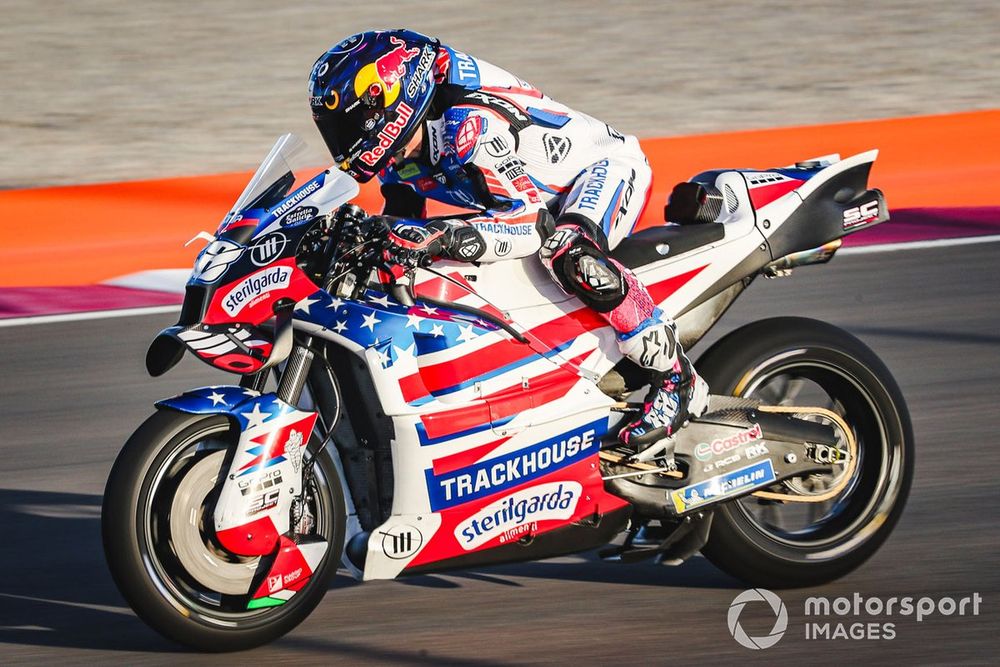
Miguel Oliveira, Trackhouse Racing Team
Photo by: Gold and Goose / Motorsport Images
“We work hard on the corner entry, so we use that to keep reducing the speed when we need to. Of course, you cannot keep much pressure when you’re in that [entry] phase of braking into the corner, so that’s where we especially use the rear brake.
“Together with the engine braking, and the rear brake, you try and work the balance to not be too sharp or aggressive as you rotate the bike into the corner, otherwise you overload the front end and that’s when you can lose the front.”
Unlike others, Oliveira doesn’t use a thumb-controlled rear brake: “I prefer to use the foot, because I can use more pressure using my foot,” he explains.
When you watch F1 you’ll often see drivers locking up their front wheels on the approach to a corner. In MotoGP, this also happens, but it is much less obvious to the watching eye…
“You feel it quite easily,” he says. “When it happens, you let it slide a little bit, you don’t release the brake immediately, you can let the bike slide a little on a locked front – but it’s really a feeling that you get used to, and you react to it quite naturally.”
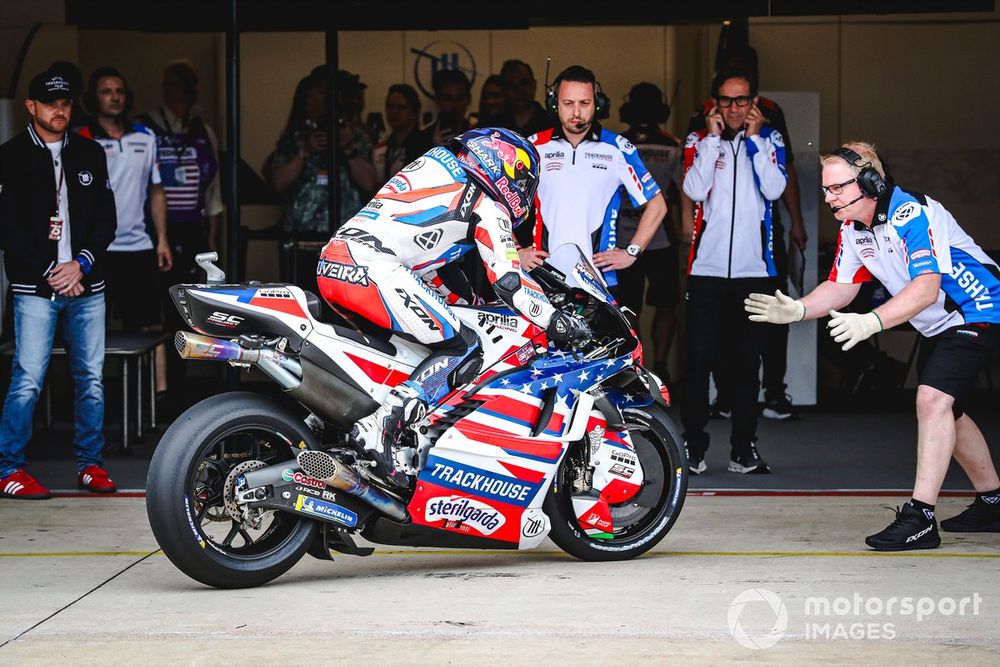
Miguel Oliveira, Trackhouse Racing Team
Photo by: Gold and Goose / Motorsport Images
And what of the force required on the lever, when you need to make a big stop? As we mentioned, F1 drivers generate huge pressure on the brake pedal in the cockpit via their foot – how about the levers in MotoGP?
“It’s not that hard, you know,” he replies. “I think it would be 11 to 12 kilos on the brake lever, to generate the strong braking power you require.
“But the main thing we need to concentrate on is how much to use it in the race, how precise you need to be at over 300km/h, the braking marks are what’s super-important, and the most difficult thing is to keep hitting them regularly in a race, when you have tire degradation and reducing fuel load. It’s not easy!”
Oliveira is also a seven-time winner in Moto2 and six-time Moto3 race victor, so well placed to compare carbon versus steel front discs.
“It’s been a long time since I rode without these brakes!” he quips. “But as I remember, it’s really that first bite that you notice the big difference. With carbon brakes – bwoah! – you really stop hard when you first hit them.”
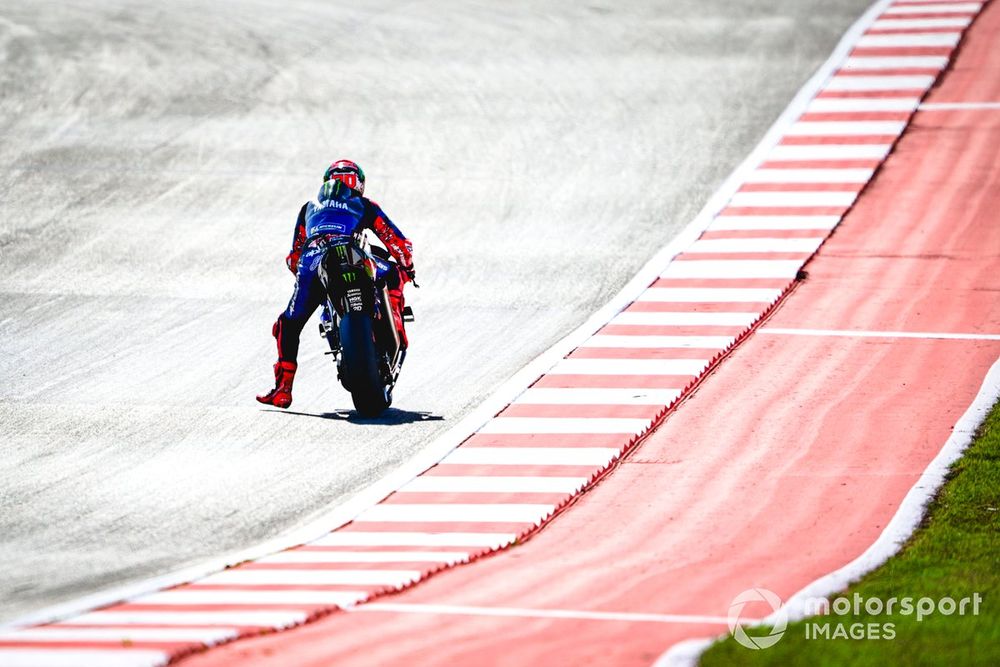
Fabio Quartararo, Yamaha Factory Racing
Photo by: Gold and Goose / Motorsport Images
Why do MotoGP riders dangle their legs under braking?
And, finally, how about the trend of riders dangling their legs out into the airstream during the braking phase? What does that achieve?
“We mainly use it as drag for air resistance,” Oliveira explains. “We also use it as a way to balance, to load the rear because once you slide sideways, you kick your leg out and that creates an inwards and downwards centre of gravity, so that helps you to slow down a bit too.”